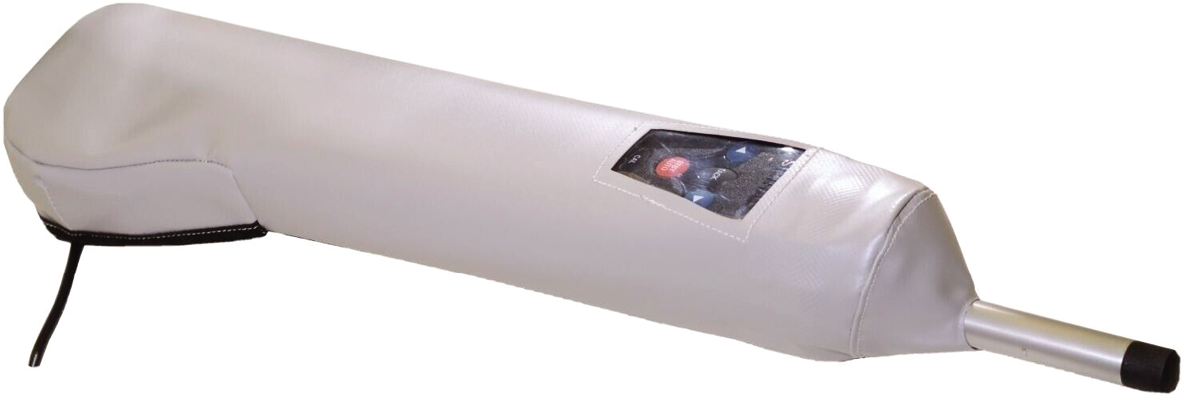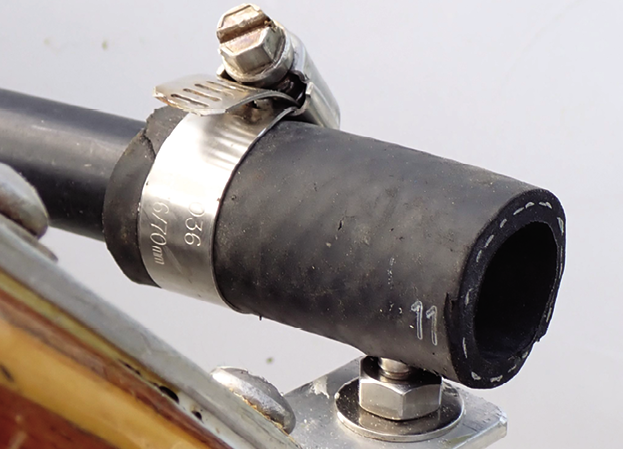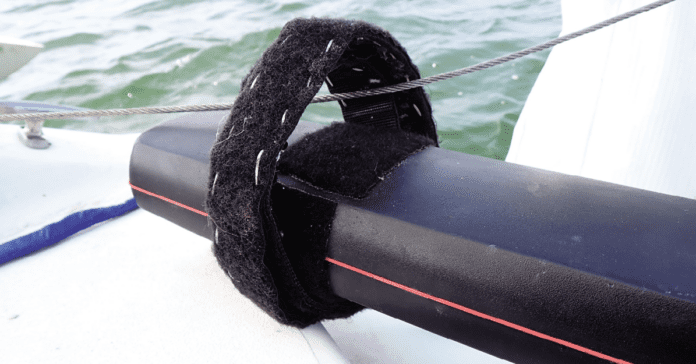Tillerpilots don’t come with the even the most basic accessories we need, so our options are to order overpriced widgets or to improvise.
RETAINER (PHOTO 1)
Many tillerpilots sit at the tail end of the cockpit, a mere slip away from a visit to Neptune.
• Attach several feet of parachute cord and a clip to the butt end of the pilot with a hose clamp.
• Wrap a Velcro “One-Wrap” loop around a lifeline. Add adhesive Velcro (loops) to the butt end of the pilot to give the hooks something to grab.
COVER (PHOTO 2)

In the UK and with many cruisers, covers are popular. Weather sealing may seem obvious or at least simple, but when you consider that a shaft must move in and out, and that considerable vacuum is generated when the unit swings from baking in the sun to cold rain, it’s a difficult and eventually unreasonable goal. As a result, the most common cause of death is water intrusion.
A vinyl coated polyester cover with a 20-mil clear vinyl patch over the keys and a Velcro closure along the belly is simple and functional (UK eBay or make your own). As an emergency expedient, some sailors keep a bread bag or newspaper bag on-board. I suggest leaving any cover off in fair weather, since a cover can hold moisture.
Although I have not heard reports of the computer going whacky in the summer sun, I’ve heard of sailors covering them to keep them cool. A white cover could make sense.
TILLER BRACKETS (PHOTO 3)

These help adjust the vertical location, For example, the tiller is commonly above the seats and so the pin will need to be slung under the tiller to keep the unit horizontal. My F-24 came from the factory with a fiberglass bracket, but I made the new custom-fit bracket from 1/8-inch x 1-inch aluminum flat bar scrap in 15 minutes for free. You can tap multiple pins into a ¼-inch flat bar and bolt that to the top of the tiller. Or you can buy something from Raymarine or Simrad for $50-$100.
DIY PUSH-ROD EXTENSION (PHOTO 4)

If you wish to test a 0.4- to 0.8-inch push-rod extensions, all that is required is a short length of stiff rubber or vinyl 0.75 ID hose. Drill a ¼-inch hole near one end, cut to length (about 2.5 inches), and secure with a hose clamp. The hole will be undersized, so you will want to work the drill back and forth until you have a snug push fit on the tiller-pin.
The exact length is fine tuned by slipping the hose up and down the push-rod in small increments until the tiller position is the same at both extremes of travel. You may even like the rubber hose tip better than the stock end fitting. We’ve sailed with this setup for thousands of miles. It is very secure and easier to operate than the stock connection, in our view.
POWER CONNECTIONS (PHOTO 5)

We’ve always found that plugs get loose after 5 years or less of regular use. Proprietary plugs can be expensive. We have had mixed success with marine plugs. After years of annoyance, we’ve converted all of our on-deck plugs to SAE 2-pin and 4-pin connectors (see Practical Sailor, August 2021, “Watertight Connector Test.”)
If you standardize the ground pin and the positive pin right next to it, then 2-pin plugs can be powered from 4-pin sockets. The key to longevity is to add waterproof grease every year. These connectors are cheap and available everywhere, including Amazon, and auto parts stores.
PUSH-ROD EXTENSIONS
Available in 1- to 6-inch lengths, push-rod extensions help with wide cockpits. They can be combined with the 0.8-inch rubber hose extension used to center the tiller on a modified installation (Photo 4). Push-rod extensions are handy if retrofitting a Simrad pilot in Raymarine mounts. We have seen push-rod extensions up to 12 inches made from aluminum tubing, slipped over the original push-rod and bonded in place with epoxy. As long as the tubing is stiff, well-fitted, and properly aligned, they work fine. A 12-inch extension is probably the practical limit.
SPARE PINS
You can make your own spare pins. Take a long ¼-inch stainless bolt, cut off the head, and a form a ball at the end using a grinder (twirl the bolt between your fingers to keep it even). Chuck the roughly-shaped pin in a drill and polish with sandpaper as it spins. If inserted into a wooden tiller, the pin should be a total of 1¾-inches, so that 1-inch can insert into the hole and the other ¾-inch exposed. If it will bolt to a bracket, you can secure it with nuts on each side. With enough threads, it can even reach through a tubular tiller. You can of course, buy a spare from Raymarine ($15, part #2319310187).
SPARE MOUNTING SOCKETS
Take a ¼-inch x 1½-inch brass plumbing nipple and drill it out to 25/64-inch (reaming the hole with 3/8-inch bit can work in a pinch). Thread a cap onto the bottom to stop water leaks, cut off to the appropriate length (just taking the threads off is about right) and epoxy it in the chosen spot. Or purchase one from Raymarine ($20, part 2319310188).
If you have a wooden or cored deck, reinforce the socket installation with solid glass backing plate and consider a G10 fiberglass or stainless pad on the top surface as well. The socket can see repeated high forces. Imagine yanking back and forth on an exposed bolt with all of your weight many thousands of times. We have seen socket mounting holes enlarged and blown out. Even the socket on our F-24 has come loose.








































As a spare mounting socket, you can also use this inexpensive bronze part from McMaster (other lengths available): https://www.mcmaster.com/6338K465/